Effect of Ca(v)beta subunits on structural organization of Ca(v)1.2 calcium channels
- PMID: 19492014
- PMCID: PMC2688388
- DOI: 10.1371/journal.pone.0005587
Effect of Ca(v)beta subunits on structural organization of Ca(v)1.2 calcium channels
Abstract
Background: Voltage-gated Ca(v)1.2 calcium channels play a crucial role in Ca(2+) signaling. The pore-forming alpha(1C) subunit is regulated by accessory Ca(v)beta subunits, cytoplasmic proteins of various size encoded by four different genes (Ca(v)beta(1)-beta(4)) and expressed in a tissue-specific manner.
Methods and results: Here we investigated the effect of three major Ca(v)beta types, beta(1b), beta(2d) and beta(3), on the structure of Ca(v)1.2 in the plasma membrane of live cells. Total internal reflection fluorescence microscopy showed that the tendency of Ca(v)1.2 to form clusters depends on the type of the Ca(v)beta subunit present. The highest density of Ca(v)1.2 clusters in the plasma membrane and the smallest cluster size were observed with neuronal/cardiac beta(1b) present. Ca(v)1.2 channels containing beta(3), the predominant Ca(v)beta subunit of vascular smooth muscle cells, were organized in a significantly smaller number of larger clusters. The inter- and intramolecular distances between alpha(1C) and Ca(v)beta in the plasma membrane of live cells were measured by three-color FRET microscopy. The results confirm that the proximity of Ca(v)1.2 channels in the plasma membrane depends on the Ca(v)beta type. The presence of different Ca(v)beta subunits does not result in significant differences in the intramolecular distance between the termini of alpha(1C), but significantly affects the distance between the termini of neighbor alpha(1C) subunits, which varies from 67 A with beta(1b) to 79 A with beta(3).
Conclusions: Thus, our results show that the structural organization of Ca(v)1.2 channels in the plasma membrane depends on the type of Ca(v)beta subunits present.
Conflict of interest statement
Figures
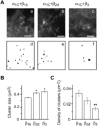
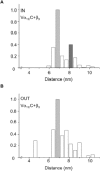
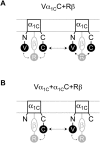
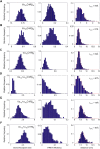

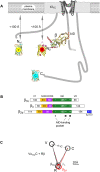
Similar articles
-
Oligomerization of Cavbeta subunits is an essential correlate of Ca2+ channel activity.FASEB J. 2010 Dec;24(12):5013-23. doi: 10.1096/fj.10-165381. Epub 2010 Aug 23. FASEB J. 2010. PMID: 20732952 Free PMC article.
-
Voltage-gated rearrangements associated with differential beta-subunit modulation of the L-type Ca(2+) channel inactivation.Biophys J. 2004 Aug;87(2):844-57. doi: 10.1529/biophysj.104.041152. Biophys J. 2004. PMID: 15298893 Free PMC article.
-
Calmodulin-dependent gating of Ca(v)1.2 calcium channels in the absence of Ca(v)beta subunits.Proc Natl Acad Sci U S A. 2008 Jun 10;105(23):8154-9. doi: 10.1073/pnas.0711624105. Epub 2008 Jun 5. Proc Natl Acad Sci U S A. 2008. PMID: 18535142 Free PMC article.
-
Calcium channel auxiliary α2δ and β subunits: trafficking and one step beyond.Nat Rev Neurosci. 2012 Jul 18;13(8):542-55. doi: 10.1038/nrn3311. Nat Rev Neurosci. 2012. PMID: 22805911 Review.
-
Structure and function of the β subunit of voltage-gated Ca²⁺ channels.Biochim Biophys Acta. 2013 Jul;1828(7):1530-40. doi: 10.1016/j.bbamem.2012.08.028. Epub 2012 Sep 7. Biochim Biophys Acta. 2013. PMID: 22981275 Free PMC article. Review.
Cited by
-
Cav1.2, cell proliferation, and new target in atherosclerosis.ISRN Biochem. 2013 May 12;2013:463527. doi: 10.1155/2013/463527. eCollection 2013. ISRN Biochem. 2013. PMID: 25937960 Free PMC article. Review.
-
Gi/o-coupled muscarinic receptors co-localize with GIRK channel for efficient channel activation.PLoS One. 2018 Sep 21;13(9):e0204447. doi: 10.1371/journal.pone.0204447. eCollection 2018. PLoS One. 2018. PMID: 30240440 Free PMC article.
-
Oligomerization of Cavbeta subunits is an essential correlate of Ca2+ channel activity.FASEB J. 2010 Dec;24(12):5013-23. doi: 10.1096/fj.10-165381. Epub 2010 Aug 23. FASEB J. 2010. PMID: 20732952 Free PMC article.
-
Down-regulation of CaV1.2 channels during hypertension: how fewer CaV1.2 channels allow more Ca(2+) into hypertensive arterial smooth muscle.J Physiol. 2013 Dec 15;591(24):6175-91. doi: 10.1113/jphysiol.2013.265751. Epub 2013 Oct 28. J Physiol. 2013. PMID: 24167226 Free PMC article.
-
Molecular Determinants of Cav1.2 Calcium Channel Inactivation.ISRN Mol Biol. 2012 Oct 17;2012:691341. doi: 10.5402/2012/691341. eCollection 2012. ISRN Mol Biol. 2012. PMID: 27335667 Free PMC article. Review.
References
-
- Clapham DE. Calcium signaling. Cell. 1995;80:259–268. - PubMed
-
- Silver RA, Lamb AG, Bolsover SR. Calcium hotspots caused by L-channel clustering promote morphological changes in neuronal growth cones. Nature. 1990;343:751–754. - PubMed
-
- Westenbroek RE, Ahlijanian MK, Catterall WA. Clustering of L-type Ca2+ channels at the base of major dendrites in hippocampal pyramidal neurons. Nature. 1990;347:281–284. - PubMed
-
- Franzini-Armstrong C, Protasi F, Ramesh V. Comparative ultrastructure of Ca2+ release units in skeletal and cardiac muscle. Ann NY Acad Sci. 1998;853:20–30. - PubMed
Publication types
MeSH terms
Substances
Grants and funding
LinkOut - more resources
Full Text Sources
Miscellaneous

